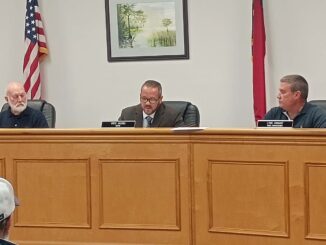
We were gifted a dandy flock of chickens the other day, so restoration of the Chicken Castle jumped to the top of the to-do list.
The castle was a gift from a neighbor several years ago, and required a tremendous amount of engineering and at least two wounded guardian angels to get home. It served the flock we had at the time until it was attacked by a zealous, hungry goat. Along the way since then it has housed snakes, cats, and the occasional possum. It also worked as an emergency goat maternity ward, but it was in no shape for chickens or other fowl, so it’s restoration was pushed to the back burner.
I ended up spending all of Saturday pulling fence wire and driving staples, digging postholes and snarling at boards that were too short. As soon as church was over Sunday I was back at it, gathering wood from the scrap pile, dodging snakes and counting staples as a missed lick of the hammer sent them flying somewhere across the Cape Fear River. I normally do not like working on Sunday, even when the work is something I find pleasurable, but the ox was in the ditch, or I guess I should more accurately say, the chickens were not in the coop.

As I (literally) crawled along, fastening a footer board to prevent any of the former residents from trespassing and cadging a free meal, it got me to thinking about chickens and chicken coops.
In a town where I once lived, there was a chicken coop that was on the National Register of Historic Places.
I’m deadly serious. The coop was a true fortress, whereas our bears the name “castle” somewhat tongue-in-cheek. The coop was professionally built of bricks, and even had running water and electricity when it was built, at a time when many humans didn’t have either luxury. The design itself was rather pedestrian: a typical shed roof, windows that could be closed for warmth or opened for ventilation, a line of roosts on one side and laying boxes on the other, and a handful of little entries leading out to where the chicken yard had once stood (also partially fenced in brick). The original owner noted in his will that he loved fresh eggs, he loved sharing fresh eggs, and he loved fried chicken, but he didn’t want his chickens wandering the neighborhood, so he gave them a home as nice as his own. People were different in the 1920s.
Our castle is nothing like that, of course, although it’s sturdier than the first one Miss Rhonda and I had. Our landlady at the time remembered when the coop was built – 1930-something – because its predecessor had burned down from a lightning strike. For years it had become a catchall shed, albeit a leaky one, but we cleaned it out and put it to good use, slapping together a small wire enclosure around the half-rotten board and batten walls.
My father insisted we at least have a good gate, so he and I spent a lovely Saturday carefully building a wood-framed, hardware cloth-covered gate that had us at wit’s end before it would finally swing and shut perfectly. One whole wall of the shed would lean with the gate. I was content to drag the gate a little, but Papa was having none of it. At least the gate was going to be right, even if I didn’t build the fence itself to his specifications. Later on I begrudgingly admitted he was right, and ended up framing the fence as it should have been done to start.
So – we ended up with a professional quality gate and a yeoman level (at best) fence, surrounding a 70-year-old coop. I ended up pulling more fence around the walls of the coop itself, since our half-potbelly, half-demon pig would open a new hole in the wall when he got bored. I finally gave up one day when I was measuring a new hole and realized there were more replacement planks than original boards. Sadly we lost all our chickens when we were hit hard by a particularly hungry predator in the next few weeks; the demonic pig ran off. I found him many months later, living his best life with a neighbor’s Duroc sow, with whom he had set up housekeeping and started a family.
Our neighbor was mystified as to the little black boar’s provenance, as well as the logistics required for a 65 pound boar to breed with a 400 pound sow, but love conquers all. I admit I feigned amazement as well. I was happy to see the little varmint gone.
I’m not sure when the trend toward cute, creative chicken coops came to life; maybe it was during COVID, when folks were trying to be ready for the end we were all assured was coming, or maybe it was just an organic market response to people wanting more chickens, and people being willing to buy cute little portable houses for their chickens. I have nothing against decorative chicken tractors; but between coyotes, bears and the wild hogs I hear squalling in the swamps past our house, I feel better with a fortified facility for our fowl. Besides, my chickens don’t care if their house is pretty.
I will likely slap a coat or two of paint on the castle sometime in the next few weeks, so it doesn’t look completely post-apocalyptic. I might even buy some of those cute little chicken saying signs for my bride, since she is the only person happier than I am about our a split level, open floor plan 10 x 30 foot theatre that features a soap opera producing eggs. Come to think of it, the only person who was ever happier than my wife to have a flock of chickens was my mother. She sometimes came to our house just to gather eggs and talk to the birds.
Mr. Majestic the rooster greets every morning in a polite manner, unlike some roosters I have known. Sarah Conner keeps the other hens in line. The Chainsaw Gang – our three Guinea fowl – want nothing more than to be left alone to eat fireants and bugs. The other ladies haven’t showed us their real personalities yet, so their names are pending.
We plopped the birds in their new world late Sunday afternoon, and I spent a good half-hour watching them scratch and peck, fluff and dust. I had to smile. I’d forgotten how nice it is to have a home flock.
One of the V for Victory campaigns during World War II encouraged people to raise backyard flocks to feed their families and support the war effort. Based on the cost of feed, I don’t think we’re supporting anything but the grain company, but I have to admit, there is a certain peace that flows from the pen when the hens dash up to the gate for a handful of corn and mealworms.
Every time I head the rooster crow, I remember the Old Man making me measure the frame to that gate one more time; whenever I hear the hens cackle in surprise at laying an egg, I hear my mother remembering fighting chicken snakes and raccoons to save every egg she could, since eggs were like gold during the Depression. I think of the sainted Mrs. Batten who lived a couple miles from me, who defended her chickens with her bare hands and strangled a bobcat to death, then posed for a picture with the cat’s carcass and her hens. I even remember our demonic pig laying underneath a hen, mouth open, waiting for her to drop an egg in his mouth.
Yes, we get eggs on a daily basis, but a little flock of chickens brings a lot more to the table than just supper, things you just can’t find packed in Styrofoam in the grocer’s cooler.






















